Volume 20, Issue 1
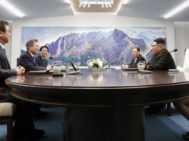
Regional Overview
January — April 2018The “Disruptor in Chief” Emerges
Since the advent of the Trump administration, US Asia policy has reflected more continuity than change. No more. The one exception has been US security policy, which continued to reflect time-honored principles, including the centrality of US alliances and deterrence. Changes have come at a breathtaking pace in the past few months. Credit (or blame) the emergence of “the real” Donald Trump, who has shrugged off the constraints and conventional wisdom that had kept him largely within the mainstream of US foreign policy practices. His decision to meet North Korean leader Kim Jong Un stunned most observers and led to a series of summits in anticipation of his historic meeting with Kim. The “Disruptor-in-Chief” was also hard at work on economic policy, with the imposition of tariffs on steel and aluminum exports by US trading partners. Trade tensions between Washington and Beijing grew throughout the first four months of 2018 and there are fears of a trade war in the absence of astute management.
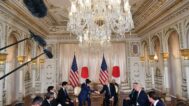
US - Japan
January — April 2018Adjusting to Abrupt Diplomacy
2018 brought with it a swirling series of summits, including another visit by Prime Minister Abe Shinzo to the United States to meet President Donald Trump. The year began with Japan and the United States toe-to-toe on their “maximum pressure” strategy toward North Korea. Four months later there was the announcement of a June 12 summit between Trump and North Korea’s leader Kim Jong Un. Tokyo and Washington have yet to come together on trade, and even at the Abe-Trump summit in mid-April, the differences were conspicuously on display. The US-Japan economic partnership remains a potential black hole for the alliance in the months ahead. But the action is in Northeast Asia for the moment, where everyone seems to be trying to meet with everyone. Nonetheless, Abe and Trump made clear in their summit their mutual goal has not changed: complete, verifiable, and irreversible denuclearization by North Korea.
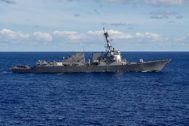
US - China
January — April 2018Hurtling Toward a Trade War
The US and China engaged in tit-for-tat trade actions as bilateral trade talks failed to produce a compromise. The Trump administration doubled down on its characterization of China as a threat to US interests in the National Defense Strategy and “Worldwide Threats” hearings on Capitol Hill. President Trump signed the Taiwan Travel Act, which calls for the US government to encourage visits between officials from the United States and Taiwan at all levels, provoking China’s ire. Cracks in US-China cooperation on North Korea were revealed as the Trump administration imposed sanctions on Chinese shipping and trading companies allegedly conducting illicit business with North Korea, and Beijing failed to notify Washington in advance of Kim Jong Un’s visit to China. The US conducted two Freedom of Navigation Operations (FONOPS) in the South China Sea.
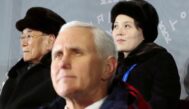
US - Korea
January — April 2018An Olympic Detente
Following weapon tests and rhetorical fury in 2017, North Korean leader Kim Jong Un signaled in his New Year address a marked turn toward improving inter-Korean relations. South Korean President Moon Jae-in seized the opening, lauded Trump’s hardline, stood up military hotlines, and moved North Korea to the Olympic moment. The PyeongChang Winter Olympics, Korea’s peace games, won early gold, despite US misgivings. Sport gave way to diplomacy, as North and South Korea agreed to a summit and Seoul sent its representatives north. President Trump surprised everyone by accepting Kim’s offer to meet. Washington and Seoul vowed to maintain maximum pressure and mute Trump trade concerns. Their de facto downgrade in the size of joint military exercises demonstrated flexibility. Seoul couched the Moon-Kim summit as a preliminary to the Kim-Trump sit down. Amid concerns of a split, Moon suggested Trump receive the Nobel Peace Prize.
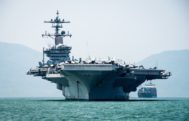
US - Southeast Asia
January — April 2018Policy on Auto-Pilot
The difficulties of the Trump administration in forging a coherent foreign policy were on display in US relations with Southeast Asia in the early months of 2018. The Department of Defense played an outsized role as both Secretary of Defense James Mattis and Chairman of the Joint Chiefs of Staff Joseph Dunford made visits to the region. The customary menu of multilateral and bilateral exercises with Southeast Asian militaries, including the 37th round of the annual Cobra Gold exercises, reassured security partners of continued defense cooperation. However, piecemeal diplomatic activity by the US underscored perceptions that the Trump administration has downplayed the region’s significance, exacerbated by heightened rhetoric about the still-undefined “free and open Indo-Pacific region.” Chinese assertiveness in the South China Sea and the Rohingya refugee crisis continued to be of mutual concern, but were overshadowed by the emerging dialogue on the Korean Peninsula and growing trade tensions between China and the US, leaving Southeast Asian governments in a reactive mode.
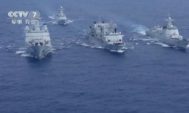
China - Southeast Asia
January — April 2018Xi Jinping Stresses Cooperation and Power – Enduring Contradiction?
Supported by Chinese officials and authoritative commentary, President Xi Jinping continued a moderate and cooperative posture toward Southeast Asia in early 2018, reaching a highpoint in Xi’s keynote address on April 10 at the annual Boao Forum for Asia in Hainan Province. Then, the posture switched dramatically to the surprise of many at home and abroad. On April 12, Xi appeared in military uniform addressing troops in the South China Sea participating in the largest naval review in China’s history. Perhaps signaling the United States, Vietnam, Japan, Taiwan, and others challenging Chinese activities in the South China Sea, the switch starkly showed the kind of power Beijing is prepared to use in pursuit of its national objectives. Most other Chinese actions toward Southeast Asia and involving the South China Sea in first four months of 2018 emphasized the positive, with China making major advances in relations, especially with the Philippines.
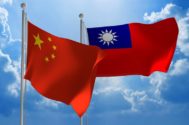
China - Taiwan
January — April 2018Taiwan Caught Between US and China
General Secretary Xi Jinping maneuvered the Chinese Communist Party (CCP) into removing term limits so that he can lead China indefinitely. Beijing has increased pressure on Taiwan, but also rolled out new measures aimed at increasing Taiwan’s economic and social integration with the mainland. On Taiwan, pro-independence elements continue pressing President Tsai Ing-wen. The passage of the Taiwan Travel Act (TTA), which was generally welcomed in Taipei, created a new US-China controversy. The appointment of John Bolton as national security advisor and the Trump administration’s tariff and technology actions against China have renewed fears in Taipei that Taiwan will become a bargaining chip or suffer collateral damage in a US-China confrontation.
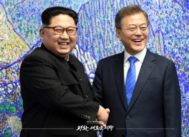
North Korea - South Korea
January — April 2018Inter-Korean Summit: Third Time Lucky?
It is a new year and there is new hope for inter-Korean relations. Beginning with Kim Jong Un’s olive branch to Seoul in his annual New Year Address, followed by the carefully coordinated display of North-South cooperation at the PyeongChang Winter Olympics, and capped off with the sometimes unctuous display of bonhomie at the inter-Korean summit in Panmunjom, the shift has been stunning. Now comes the hard part: implementation. The product of the summit, the Panmunjom Declaration, lays out clear milestones to mark progress for improving inter-Korean relations. We expect the North this time to deliver with the South, as a ploy to help it postpone or spin out denuclearization. How these two diplomatic tracks – local and multifaceted on the peninsula, but single-mindedly nuclear on the global stage and especially in Washington – will play out and interact is the key issue.
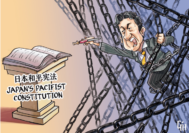
Japan - China
January — April 2018Warmer Words, Continuing Defense Preparations
Chinese President Xi Jinping successfully presided over the Boao Forum indicating progress toward establishing China as the fulcrum of the international trading system. Meanwhile, Japanese Prime Minister Abe Shinzō’s political future was clouded by the Moritomo Gakuen scandal. Formal high-level dialogue between Beijing and Tokyo, interrupted since September 2010 was cautiously reinstated in April. In the same month, lower-level military exchanges resumed after a six-year hiatus. Despite talk of resetting relations, there was no resolution of key issues such as the disposition of disputed islands in the East China Sea or of present-day Japanese responsibility for the country’s conduct during World War II. As for trade, although both China and Japan are committed in theory to early conclusion of the Regional Economic Cooperation Partnership agreement, Japan favors a deal closer to the Trans-Pacific Partnership while China wants additional concessions to support its economic reform goals. Nonetheless, China hopes to obtain Japanese participation in its Belt and Road Initiative.

China - Korea
January — April 2018Moon’s Olympic Diplomacy
The early months of 2018 may well be remembered as Kim Jong Un’s coming-out party. Beginning with his New Year speech calling for better inter-Korean relations, he suddenly became the topic of global attention and the “must have” partner for summits with both friend and foe. After seven years without any direct contact, Kim managed to meet both President Xi Jinping and President Moon Jae-in, and get a commitment for a meeting with US President Donald Trump within the span of two months. With the PyeongChang Winter Olympic Games and the flurry of diplomatic activity surrounding the Kim-centered summits serving as the primary catalysts, the prospect for a “breakthrough on the peninsula” became the central focus for China-Korea relations.
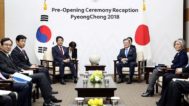
Japan - Korea
January — April 2018The North Korea Factor
In the first four months of 2018, Japan’s relationship with South Korea was influenced more than ever by North Korea as a thaw in inter-Korean relations created a new dynamic for Japan-Korea relations. The shift began with Kim Jong Un’s expressed hope for improvement in Seoul-Pyongyang relations and inter-Korean talks in his 2018 New Year’s speech. The PyeongChang Winter Olympics created significant momentum and the inter-Korean summit in late April put an exclamation mark on the dramatic turnabout. While Moon Jae-in’s administration welcomed the initiative from the North with guarded optimism and facilitated the improvement in relations as the gracious host for both the Olympics and the summit, the Abe administration kept a skeptical and indeed critical stance toward North Korea’s “charm offensive.” However, Japan was forced to move away from its hardline policy in the face of inter-Korean bonhomie and when the US recognized the shift as an opportunity to move toward diplomacy with North Korea.
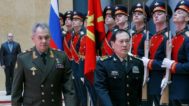
China - Russia
January — April 2018Absorbing Shock and Awe: Trump Style
A year into Donald Trump’s presidency, both China and Russia have found themselves in a more difficult relationship with the United States. For the first time in history, the two large powers were characterized as “revisionists,” “strategic competitors,” and “rivals” in a series of US strategy documents: the 2017 National Security Strategy (NSS), 2018 National Defense Strategy (NDS) and 2018 Nuclear Posture Review (NPR). In practical terms, the US threatened Beijing with a trade-war and tried to play the Taiwan card, while punishing Russia with Syria bombings and diplomat expulsions. Meanwhile, Russian President Putin secured his next six years, his fourth term in office, with 77 percent of the vote while President Xi Jinping succeeded in ending a two-term limit on the PRC presidency. At the onset of 2018, the three largest powers in the world were in the hands of strongmen and the world was in uncharted waters as the US appeared ready to simultaneously take on China and Russia as its main rivals for the first time since the early 1970s.
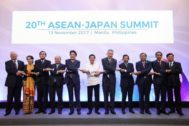
Japan - Southeast Asia
May 2017 — April 2018Redirecting Strategic Focus in the Age of the Indo-Pacific
Japan and Southeast Asia faced a new regional dynamic in 2017 following the inauguration of President Donald Trump in the United States and Philippine President Rodrigo Duterte’s accommodative foreign policy toward China. US withdrawal from the Trans-Pacific Partnership and the Philippines’ unwillingness to discuss the 2016 South China Sea arbitration award forced Japan and some Southeast Asian states to redirect their strategic focus. Most Southeast Asian states increasingly welcome Japan’s regional initiatives in trade, security, and development to fill the vacuum created by these policy shifts. Japan has actively emphasized the “Free and Open Indo-Pacific Strategy,” the geographic scope of which goes well beyond East Asia and covers the entire Pacific Ocean to East Africa. This new strategic focus has revitalized Japan’s cooperation with Southeast Asia. Nevertheless, there are serious challenges that Japan needs to overcome, particularly in clarifying ASEAN’s roles in the strategy.